Table of contents
In the face of increasing climate variability, limited land resources, and the growing demand for high-quality agricultural produce, Indian farmers are increasingly turning to innovative farming techniques. Polyhouse farming, a form of protected cultivation, offers a promising solution by creating a controlled environment for crop growth. This method allows for year-round cultivation, higher yields, improved quality, and efficient use of resources. This comprehensive guide will delve into the world of polyhouse farming in India, exploring its definition, types, costs, suitable crops, benefits, and future potential.
What is a Polyhouse?
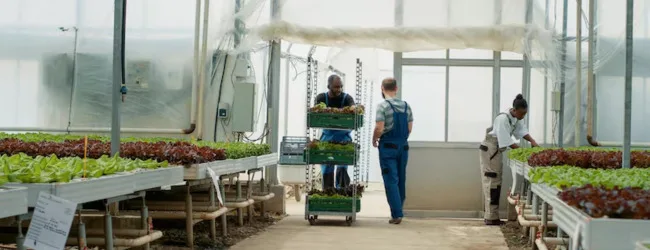
A polyhouse, also known as a greenhouse, is a framed or inflated structure covered with translucent polyethylene (poly) film. This covering allows sunlight to penetrate for plant growth while protecting the crops from adverse weather conditions such as heavy rain, strong winds, extreme temperatures, hail, and frost. Polyhouses create a microclimate inside, allowing farmers to regulate temperature, humidity, and ventilation to optimize plant growth and development, regardless of the external environment. This controlled environment also offers protection from pests and diseases, reducing the need for chemical interventions.
Different Types of Polyhouse Farming
Polyhouses can be categorized based on their design, size, and the level of environmental control they offer. Here are some common types:
- Naturally Ventilated Polyhouses (Low-Cost Polyhouses): These are the most common and affordable type, particularly suitable for small and marginal farmers. They rely on natural ventilation through openings on the sides and roof to regulate temperature and humidity. These polyhouses are effective in providing basic protection from weather and pests but offer limited environmental control.
- Environmentally Controlled Polyhouses (High-Tech Polyhouses): These sophisticated structures are equipped with advanced systems for precise control over temperature, humidity, light intensity, carbon dioxide levels, and irrigation. These systems include:
- Heating and Cooling Systems: To maintain optimal temperature ranges.
- Humidity Control Systems: Through foggers, misters, or dehumidifiers.
- Ventilation Systems: Automated fans and vents for air exchange.
- Shading Nets: To regulate light intensity.
- CO2 Enrichment Systems: To enhance photosynthesis.
- Automated Irrigation and Fertigation Systems: For efficient water and nutrient delivery. These polyhouses require a significant initial investment but offer the potential for maximum yield and quality, especially for high-value crops.
- Fan and Pad Polyhouses: These polyhouses utilize an evaporative cooling system. Fans are installed at one end to draw air through cooling pads saturated with water at the opposite end. As the air passes through the pads, it cools down due to evaporation, providing a relatively effective cooling solution for hot and dry climates.
- Shade Net Houses: While technically not fully enclosed polyhouses, shade net houses provide a level of protection from excessive sunlight, hail, and certain pests. They are covered with shade nets of varying percentages to control light intensity and are a more cost-effective option for certain crops.
- Walk-in Tunnels: These are smaller, semi-circular or rectangular structures covered with polyethylene film. They are relatively inexpensive and easy to construct, suitable for growing vegetables and flowers on a smaller scale. Ventilation is typically manual through roll-up sides.
The choice of polyhouse type depends on factors such as the farmer’s budget, the type of crops to be grown, the prevailing climatic conditions, and the desired level of environmental control.
Polyhouse Construction Cost in India
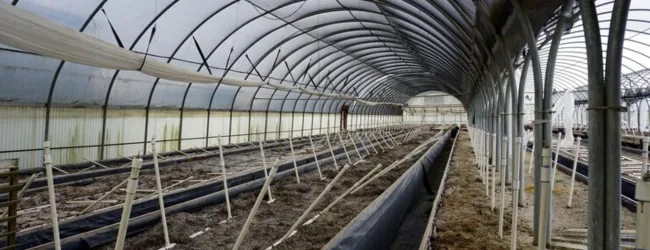
The cost of constructing a polyhouse in India can vary significantly based on several factors:
- Type of Polyhouse: Naturally ventilated polyhouses are the most affordable, with costs ranging from ₹150 to ₹500 per square meter. Environmentally controlled or high-tech polyhouses are significantly more expensive, with costs potentially ranging from ₹800 to ₹2500 or more per square meter, depending on the sophistication of the control systems. Fan and pad polyhouses fall somewhere in between.
- Size of the Polyhouse: Larger polyhouses generally benefit from economies of scale, reducing the per-unit cost.
- Quality of Materials: The thickness and quality of the polyethylene film, the strength and type of the structural frame (bamboo, GI pipe, steel), and the quality of other components (ventilation systems, irrigation) will affect the cost.
- Location: Transportation costs of materials and labor charges can vary depending on the location.
- Government Subsidies: The Indian government and various state governments offer subsidies and financial assistance for polyhouse construction under schemes like the National Horticulture Mission (NHM) and Mission for Integrated Development of Horticulture (MIDH). These subsidies can significantly reduce the initial investment burden. Farmers should research and avail these schemes.
- Automation Level: The level of automation (irrigation, climate control) directly impacts the cost.
It is crucial for farmers to prepare a detailed project report and get accurate cost estimates from reliable polyhouse manufacturers and installers, considering their specific requirements and location.
ALSO READ | Avocado Farming in India: A Complete Guide
Suitable Crops That Can Be Grown in a Polyhouse
The controlled environment of a polyhouse allows for the cultivation of a wide range of high-value crops, extending the growing season and improving quality. Here is a detailed list of suitable crops:
Vegetables
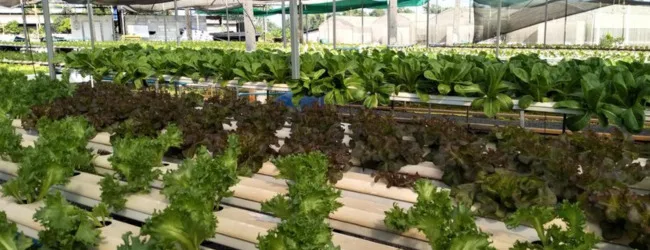
- Tomatoes: Polyhouses provide ideal conditions for growing high-quality, disease-free tomatoes with extended fruiting periods. Various types, including cherry, plum, and hybrid varieties, thrive well.
- Cucumbers: Both slicing and pickling cucumbers benefit from the controlled temperature and humidity, resulting in higher yields and better quality.
- Capsicum (Bell Peppers): Red, yellow, and green capsicums flourish in polyhouses, producing larger, more uniformly colored fruits with reduced pest and disease incidence.
- Chilli Peppers: High-value chilli varieties, including exotic and hybrid types, can be grown successfully in polyhouses, offering better yields and quality.
- Lettuce and Other Leafy Greens: Spinach, kale, Swiss chard, and various types of lettuce grow well in the protected environment, allowing for year-round production of clean, tender leaves.
- Exotic Vegetables: Vegetables like broccoli, cauliflower (especially off-season), zucchini, and asparagus can be cultivated under controlled conditions for better quality and market value.
- Eggplant (Brinjal): Certain high-yielding and disease-susceptible eggplant varieties benefit from polyhouse cultivation.
- Melons (Watermelon, Muskmelon): Early and off-season cultivation of melons is possible in polyhouses, fetching premium prices.
Flowers
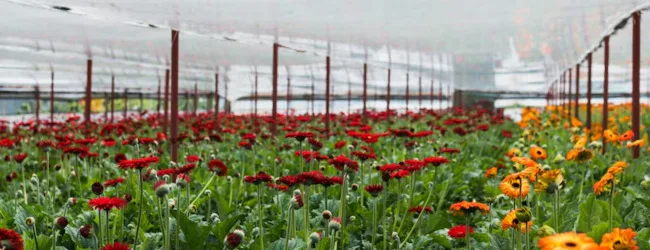
- Roses: Polyhouses are extensively used for commercial rose cultivation, allowing for year-round production of high-quality blooms for the cut flower market. Different varieties for cut flowers can be grown.
- Gerbera: These vibrant flowers thrive in the controlled environment, producing long stems and a wide range of colors for the floriculture industry.
- Carnations: Polyhouses provide the ideal conditions for growing high-quality carnations with long stems and consistent flower size.
- Orchids: Certain delicate orchid varieties require the controlled humidity and temperature offered by polyhouses.
- Anthuriums: These exotic flowers with their unique shapes and colors are well-suited for polyhouse cultivation.
- Lilies: Both Asiatic and Oriental lilies can be grown in polyhouses for the cut flower market.
- Chrysanthemums: Off-season and high-quality chrysanthemum production is possible in polyhouses.
Fruits
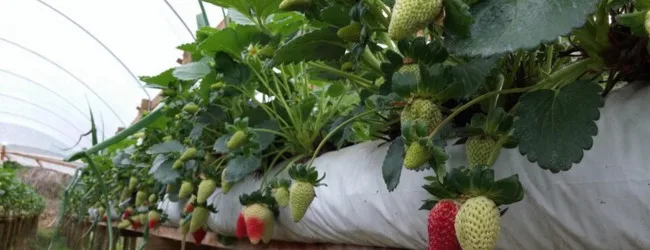
- Strawberries: Polyhouses extend the strawberry growing season, allowing for early and late harvests of high-quality berries, protected from rain and soil-borne diseases.
- Grapes (Table Grapes): In some regions, polyhouses are used for early or off-season grape production, improving fruit quality and reducing disease pressure.
- Dwarf Fruit Trees (e.g., certain varieties of mango, papaya): With proper management and pruning, dwarf varieties of some fruit trees can be grown in larger polyhouses for early yields or in regions with marginal climates.
Other High-Value Crops
- Medicinal Herbs: Certain high-value medicinal herbs that require controlled environments can be grown in polyhouses.
- Seedlings and Nurseries: Polyhouses provide an ideal environment for raising healthy and vigorous seedlings for various crops.
💡Pro Tip: If you want to start a business but have too many doubts, connect with a business expert from Boss Wallah for guidance – https://bw1.in/1116
Key Considerations for Crop Selection
- Market Demand: Choose crops with high market demand and good prices in your target market.
- Climatic Suitability (Even Inside the Polyhouse): While polyhouses offer control, understanding the basic climatic preferences of the crops is still important.
- Technical Expertise: Select crops that you have or can acquire the necessary technical knowledge to cultivate successfully in a controlled environment.
- Pest and Disease Susceptibility: Consider the common pests and diseases associated with the chosen crops and your ability to manage them in a polyhouse.
- Yield Potential and Profitability: Analyze the potential yield and profitability of different crops under polyhouse conditions.
Benefits of Polyhouse Farming in India
Adopting polyhouse farming in India offers numerous advantages for farmers:
- Higher Yields: Controlled environment leads to optimized growth conditions, resulting in significantly higher yields per unit area compared to open-field farming.
- Extended Growing Season: Farmers can grow crops year-round, regardless of the external weather, allowing for multiple cropping cycles and higher annual production.
- Improved Quality: Protection from rain, wind, and pests results in higher quality produce with better appearance, size, and nutritional value, fetching premium prices in the market.
- Reduced Pest and Disease Incidence: The enclosed environment minimizes the entry of pests and reduces the spread of diseases, leading to lower pesticide usage and healthier crops.
- Efficient Water and Fertilizer Use: Controlled irrigation and fertigation systems allow for precise delivery of water and nutrients, reducing wastage and improving resource efficiency.
- Cultivation of Off-Season Crops: Polyhouses enable farmers to grow crops during their off-season, when market prices are typically higher.
- Protection from Adverse Weather: Crops are shielded from damaging weather events like heavy rain, hail, strong winds, extreme temperatures, and frost.
- Better Crop Uniformity: Controlled conditions lead to more uniform growth and maturity of crops, simplifying harvesting and marketing.
- Suitability for High-Value Crops: Polyhouses are ideal for cultivating high-value vegetables, flowers, and fruits, maximizing returns for farmers.
- Creation of Rural Employment: The expansion of polyhouse farming can generate employment opportunities in rural areas.
Future Profit Potential
The future profit potential of polyhouse farming in India is very promising due to several converging factors:
- Increasing Demand for High-Quality Produce: Growing urbanization, rising disposable incomes, and increasing health awareness are driving the demand for high-quality, pesticide-free fruits and vegetables.
- Government Support and Subsidies: Continued government support through various schemes will make polyhouse farming more accessible to farmers.
- Technological Advancements: Innovations in polyhouse design, climate control systems, and automation will further enhance efficiency and profitability.
- Integration with Supply Chains: Better linkages with organized retail, food processing industries, and export markets will ensure stable demand and better prices for polyhouse-grown produce.
- Climate Change Resilience: Polyhouse farming offers a more resilient agricultural system in the face of increasing climate variability and unpredictable weather patterns.
- Potential for Niche Markets: Growing exotic vegetables, flowers, and medicinal herbs in polyhouses can tap into niche markets with high profit margins.
- Reduced Post-Harvest Losses: The controlled environment often leads to better quality produce with a longer shelf life, reducing post-harvest losses and increasing profitability.
Farmers who adopt modern polyhouse techniques, focus on market-driven crop selection, and manage their operations efficiently are likely to realize significant profit potential in the years to come.
Key Takeaways
- Polyhouse farming offers a controlled environment for higher yields and better quality crops.
- Different types of polyhouses cater to varying budgets and levels of environmental control.
- Construction costs vary based on type, size, and automation, with government subsidies available.
- A wide range of high-value vegetables, flowers, and fruits can be successfully grown in polyhouses.
- Benefits include higher yields, extended growing seasons, improved quality, and efficient resource use.
- The future profit potential is significant due to increasing demand, government support, and technological advancements.
- Careful planning, market analysis, and technical knowledge are crucial for success in polyhouse farming.
Need Expert Guidance?
Starting a business can be challenging, but you don’t have to do it alone! At Boss Wallah, our 2,000+ business experts are ready to provide valuable insights and guidance. Whether you need help with marketing, finance, sourcing, or any other area of any business, our business experts are here to help you succeed- https://bw1.in/1116
Confused about Which Business to Start?
Want to start your own business but unsure which one to choose? Explore Boss Wallah, where you’ll find 500+ courses by successful business owners, featuring practical, step-by-step guides on starting and growing various businesses. Find your perfect business idea today – https://bw1.in/1111
Conclusion
Polyhouse farming represents a significant step towards modernizing Indian agriculture. By providing a protected and controlled environment, it empowers farmers to overcome the limitations of traditional farming, achieve higher productivity, improve crop quality, and enhance profitability. As India continues to strive for food security and sustainable agricultural practices, polyhouse farming is poised to play an increasingly vital role in shaping the future of the agricultural sector, offering a pathway to prosperity for farmers and ensuring a consistent supply of high-value produce for consumers.
FAQs
1. Is polyhouse farming expensive to maintain?
- Maintenance costs include electricity for climate control (in high-tech polyhouses), water, fertilizers, pesticides (if needed), and periodic replacement of the poly film. While there are ongoing costs, the higher yields and quality often offset these expenses.
2. What is the lifespan of a polyhouse structure?
- The lifespan of a polyhouse structure depends on the quality of materials used. A well-constructed polyhouse with a sturdy frame can last for 15-20 years or more, while the polyethylene film typically needs replacement every 3-5 years.
3. Do polyhouses require a lot of water?
- Polyhouses, when coupled with efficient irrigation systems like drip irrigation, can actually lead to water conservation compared to open-field farming due to reduced evaporation and targeted water delivery.
4. Can organic farming be done in a polyhouse?
- Yes, organic farming practices can be effectively implemented in a polyhouse as the controlled environment helps in reducing pest and disease pressure, minimizing the need for synthetic pesticides and fertilizers.
5. What is the ideal size for a polyhouse?
- There is no ideal size; it depends on the farmer’s land availability, investment capacity, target crops, and market demand. Polyhouses can range from small walk-in tunnels to large commercial structures covering several hectares.
6. How can small and marginal farmers benefit from polyhouse farming?
- Government subsidies and the potential for growing high-value crops on smaller landholdings make polyhouse farming a viable option for small and marginal farmers to increase their income and productivity.
7. What are the essential factors to consider before setting up a polyhouse?
- Key factors include market demand for the chosen crops, availability of financial resources (including subsidies), technical knowledge, suitable location with good connectivity, and access to reliable suppliers and support services.
8. Are there any specific training programs for polyhouse farming in India?
- Yes, various agricultural universities, research institutions, and government agencies offer training programs and workshops on polyhouse technology and management. Farmers should



